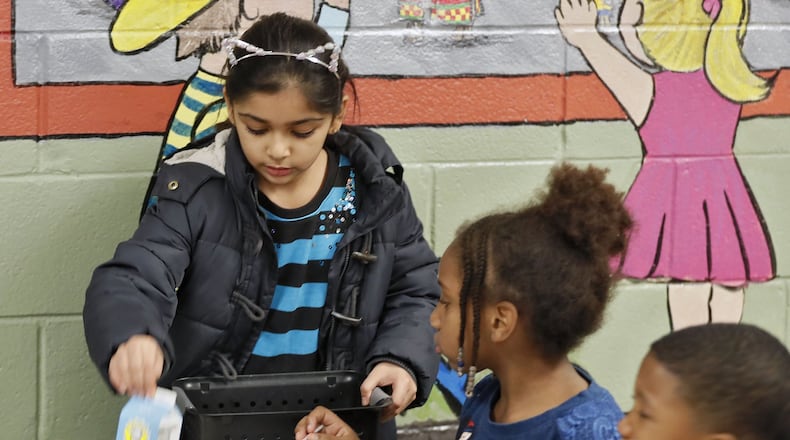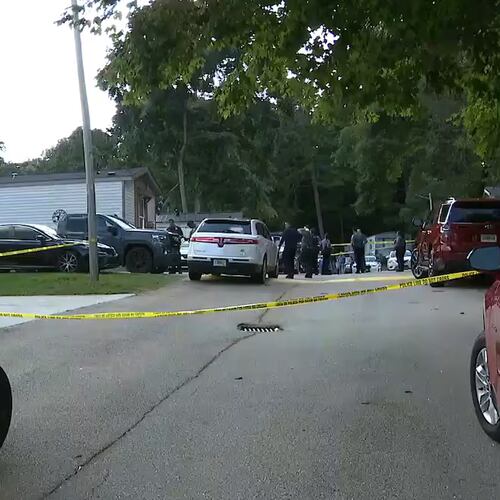The days of kids striving for membership in the ‘clean plate club’ are long past — or are they?
Several Gwinnett County schools are participants a nationwide initiative on food waste and its impact on the planet. Students’ findings have led to changes that mean a lot less food ends up in the garbage.
At Mason Elementary, one of 13 Gwinnett schools in the Food Waste Warriors project, the third grade class took on the task of determining how much food is wasted, why it’s wasted and finding ways to turn those numbers around.
The students, and parent volunteers, separated the different types of waste and weighed it. They charted the results and compared each result with the previous one. The school did six such audits in all.
After realizing that portions were the same no matter the size of the student or the size of the appetite, the cafeteria got rid of the plastic “clamshell” containers for individual servings and spooned portions right onto the tray.
“That cut down on waste significantly,” said teacher Amy Mock, whose class participated in the audits.
Related story: Gwinnett schools launch program to look at lunch waste
Related story: Farm to school good for kids, farmers
Related story: Gwinnett employees treated to same meal the kids eat
Even though milk must be available, children are not required to take a milk every day. With that understanding, many opted for water instead.
Another effort to cut down what ended up in the trash was launching a food share table.
“If you take a banana or a package of apple slices and then decide that you don’t want it, you can let it go to the share table and someone else can eat it,” said Anya Endrabi.
As designated helpers, Anya and fellow student Blessy Immadishetti take a basket and retrieve unopened foods after lunch. The cafeteria can’t re-serve items that have been picked up but not eaten, but there’s no reason another student who might want a little extra can’t have them.
As students pass by the share table those who’d like extra are allowed to take what they want.
“It works very well,” said Mock. “We’ve seen a significant decline in food thrown out, especially milk, because of it.”
Near the share table there’s also a refrigerator that was donated by Gwinnett Clean and Beautiful to store items such as milk, juice and gelatin that must be stored cold.
By February the school hopes to have a composting program in place. A local Eagle Scout built the bins.
“We just need to work out the logistics,” said assistant principal Nick Boyers.
The Food Waste Warriors program is sponsored by the World Wildlife Fund.
Students’ findings produced one of the largest studies on plate waste in school cafeterias to date, from 46 schools in nine U.S. metropolitan areas: Atlanta, Boulder, Colo.; Cincinnati, Columbus, Ohio; Indianapolis, Nashville, Phoenix, Portland, and Seattle over six months. It not only measured food and milk winding up in the trash, but also armed students with an understanding of the connections between food, waste, and the environment, while encouraging them to brainstorm how to begin to reduce that waste.
“Producing food has a tremendous impact on our planet and biodiversity, but the plate-to-planet connection is not always made,” said Pete Pearson, World Wildlife Fund’s senior director of food loss and waste. “By raising awareness on the issue of waste and engaging champions in our schools, we can inspire the next generation of students to tackle the global food waste challenge.”
Participating schools on average produced approximately 39.2 pounds of food waste and 19.4 cartons of milk waste per student per year. Throughout the four-to-six-week audit period, all participating schools saw reductions in their food waste — on average 3% from first to last audit — just by measuring what was going in the trash. Elementary schools showed even more promise, averaging a 14.5% reduction, with the top three performing schools reducing food waste by an average of 53%.
Based on the results from this sample, food waste in schools could amount to an estimated 530,000 tons per year, costing as much as $9.7 million per day or $1.7 billion every school year.
An effort to cut down food waste had already been going on in several Gwinnett schools, sponsored by Gwinnett Clean and Beautiful, a local affiliate of Keep American Beautiful. Instead of re-inventing the wheel, the Food Waste Warrior program used those same principles and tools, such as the audits, in all its participating school districts.
“We were pretty ecstatic that our little grassroots organization was having such a big impact,” said Schelly Marlatt, CEO. “Hunger is a major concern globally and by cutting down on waste that goes in landfills and making sure it’s getting into a hungry belly makes that a win-win.”
With help from Lowe’s, which provided buckets for food collection as well as gloves and scales to weigh food, the students caught on quickly how to conduct the audits.
“It was also very eye-opening that they did it themselves,” said Marlatt. “With all the milk cartons lined up the students realized how they were throwing away a valuable resource.”
Another change resulting from the audits is many of the participating schools have done away with styrofoam lunch trays and now use a pressed-paper design that breaks down much easier in a landfill.
Every corner of the world can have a profound effect on other parts of the planet, Pearson pointed out.
“It takes a lot of resources to produce food, and throwing it away can impact biodiversity. We have to do more to reduce our footprint and look for ways to be strategic about conservation,” he said.
Growing the next generation of adults who make conscious efforts to save the planet doesn’t involve much preaching, said Pearson.
“Kids want to do things about the planet. All we have to do is let them see the problem and they passionately want to find solutions.”
The fact that the initiative is student-led also impacts parents and other adults. WWF hopes to see the food waste reduction efforts as a standard school practice nationwide in the next five years.
“One of the most important components of making this work is buy-in,” said Mason principal David Jones. “Not only are the students excited about it, we have support from the community, the central office, parents and staff.”
Food Waste Warriors school lunch audits in metro Atlanta by the numbers
13 Gwinnett County schools participated
31 Food waste audits conducted
55,969 Cartons of milk thrown away
28.4 Cartons of milk per student
95,169 Pounds of waste per school
48.5 Pounds of waste per student
Source: Food Waste Warriors: A Deep Dive Into Food Waste in US Schools
Preventing food waste
These are some of the World Wildlife Fund’s recommendations to help schools.
• Run a consistent schedule of student-led audits to give schools a picture of what and how much is being wasted and reasons why food items are being discarded. Use this information to have regular conversations on waste reduction.
• Share table
• Bulk milk service
• Increase opportunities for students to access surplus food items, via share tables, afterschool programs, and/or take-home snack or “backpack” initiatives.
• Explore options to recycle remaining food scraps.
• Regular monthly “try days”, taste tests, or cooking demos
Source: “Food Waste Warriors: A Deep Dive Into Food Waste in US Schools”
About the Author
The Latest
Featured



